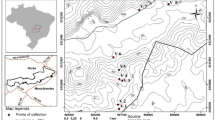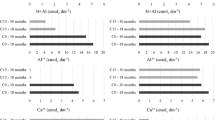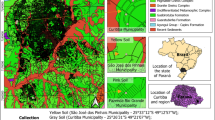Abstract
Purpose
One important group of soils that has not been well studied yet belongs to the hardsetting horizons. These soils have been characterized through basic physical property measurements (porosity, bulk density, particle size distribution). XRD and XRF analytical techniques and the interaction of radiation (X and γ-rays) through the soil can also be interesting tools for a better understanding of the properties of these soils. This work presents the chemical and mineralogical properties of Brazilian hardsetting soils and their effects on the radiation attenuation characteristics.
Materials and methods
The mass attenuation coefficient (μm) of hardsetting soils was calculated by using the XCOM computer code based on the chemical composition of the soils. Soil samples derived from different regions of Brazil were collected in the hardsetting horizons. Each sample was mashed, sieved, and submitted to dispersion and physical fractioning process by sedimentation. Semi-quantitative elemental analysis of the soils was accomplished through EDXRF. Based on the soil chemical composition analyses, the contribution of the photoelectric absorption and incoherent and coherent scatterings were investigated. The mineralogical composition was determined through the Rietveld method combined with X-ray diffraction (RM-XRD) data.
Results and discussion
The soil mass attenuation coefficient decreased increasing the photon energy as expected. A great decrease was observed in the low photon energy region, where the contribution of the photoelectric absorption was dominant. Regarding the intermediate photon energy region, where the contribution of the incoherent scattering was dominant, only a slight decrease was observed in μm with photon energy. Strong positive and moderate negative linear correlations were found between μm and Fe2O3 and SiO2 oxides. The highest mineral percentages found for the hardsetting soils were quartz, kaolinite, and halloysite. Strong positive (photoelectric absorption) and negative (coherent and incoherent scatterings) correlations were found for goethite.
Conclusions
Increase in the percentage of goethite and kaolinite influences increase in μm. The same behavior could be observed in relation to the contribution of the photoelectric absorption to μm. On the other hand, an increase in the amount of these two minerals presented a decrease in the contribution of the coherent and incoherent scatterings to μm. Therefore, in the absence of XRF analyses, the mineralogical soil measurements carried out through RM-XRD might be an interesting tool to infer the radiation attenuation characteristics of hardsetting soils. Such results bring a new insight into the radiation interaction through soils due to the analysis of the influence of the minerals in the photon attenuation.





Similar content being viewed by others
References
Abdel-Rahman MA, Badawi EA, Abdel-Hady YL, Kamel N (2000) Effect of sample thickness on the measured mass attenuation coefficients of some compounds and elements for 59.54, 661.6 and 1332.5 keV γ-rays. Nucl Instrum Meth A 447:432–436
Balan E, Lazzeri M, Morin G, Mauri F (2006) First-principles study of the OH-stretching modes of gibbsite. Am Mineral 91:115–199
Becher HH, Breuer J, Klingler B (1997) An index value for characterizing hardsetting soils by fall-cone penetration. Soil Technol 10:47–56
Berger MJ (2009) XCOM: Photon cross sections database. NIST Standard Reference Database 8 (XGAM). http://physics.nist.gov/PhysRefData/Xcom/html/xcom1.html
Berger MJ, Hubbell JH (1987) NBS 87-3597. National Institute of Standards, Gaithersburg MD USA
Bish DL, Dreele RB (1989) Rietveld refinement of non-hydrogen atomic positions in kaolinite. Clay Clay Miner 37:289–296
Bresson LM, Moran CJ (2004) Micromorphological study of slumping in a hardsetting seedbed under various wetting conditions. Geoderma 118:277–288
Brinatti AM, Mascarenhas YP, Pereira VP, Partiti CSM, Macedo A (2010) Mineralogical characterization of a highly-weathered soil by the Rietveld Method. Sci Agric 67:454–464
Cesareo R, Assis JT, Crestana S (1994) Attenuation coefficients and tomographic measurements for soil in the energy range 10-300 keV. Appl Radiat Isotopes 45:613–620
Chan KY (1995) Strength characteristics of a potentially hardsetting soil under pasture and conventional tillage in the semi-arid region of Australia. Soil Till Res 34:105–113
Corrêa MM, Ker JC, Barrón V, Torrent J, Curi N, Torres TCP (2008) Physical, chemical, mineralogical and micromorphological characterization of cohesive horizons and fragipans of red and yellow soils of Coastal Tablelands. Rev Bras Cienc Solo 32:297–313
Costa JC, Borges JAR, Pires LF, Arthur RCJ, Bacchi OOS (2014) Soil mass attenuation coefficient: analysis and evaluation. Ann Nucl Energy 64:206–211
Demir D, Un A, Ozgul M, Sahin Y (2008) Determination of photon attenuation coefficient, porosity and field capacity of soil by gamma-ray transmission for 60, 356 and 662 keV gamma rays. Appl Radiat Isotopes 66:1834–1837
Dias Junior MS, Silva SR, Santos NS, Araujo-Junior CF (2008) Assessment of the soil compaction of two Ultisols caused by logging operations. Rev Bras Cienc Solo 32:2245–2253
Dias NM, Gonçalves D, Leite WC, Brinatti AM, Saab SC, Pires LF (2013) Morphological characterization of soil clay fraction in nanometric scale. Powder Technol 241:36–42
Empresa Brasileira de Pesquisa Agropecuária (Embrapa) (2006) Brazilian soil classification system, 2nd edn. Centro Nacional de Pesquisas de Solos, Rio de Janeiro (in Portuguese)
Ferraz ESB, Mansell RS (1979) Determining water content and bulk density of soil by gamma-ray attenuation methods. Technical Bulletin, N°. 807, IFAS, Flórida., p 51
Ferreira CA, Silva AC, Torrado PV, Rocha WW (2010) Genesis and classification of Oxisols in a highland toposequence of the upper Jequitinhonha valley (MG). Rev Bras Cienc Solo 34:195–209
Geward L, Guilbert N, Jensen KB, Levring H (2004) WinXCOM—a program for calculating X-ray absorption coefficients. Radiat Phys Chem 71:653–654
Giarola NFB, Silva AP, Imhoff S, Dexter AR (2003) Contribution of natural soil compaction on hardsetting behavior. Geoderma 113:95–108
Gomes JBV, Fernandes MF, Barreto AC, AraújoFilho JC, Curi N (2012) Soil attributes under agroecosystems and forest vegetation in the coastal tablelands of Northeastern Brazil. Ci Agrotec 36:649–664
Gualtieri F, Venturelli P (1999) In situ study of the goethite-hematite phase transformation by real time synchrotron powder diffraction. Am Mineral 84:895–904
Horn M, Schwerdtfeger CF, Meagher EP (1972) Refinement of the structure of anatase at several temperatures. Kristallogr Krist 136:273–281
Kaplan I (1963) Nuclear physics, 2nd edn. Addison-Wesley, Reading
Knoll GF (2010) Radiation detection and measurement, 4th edn. John Wiley and Sons, New Jersey
Kucuk N, Cakir M, Isitman NA (2013) Mass attenuation coefficients, effective atomic numbers and effective electron densities for some polymers. Radiat Prot Dosim 153:127–134
Larson AC, Dreele RB (2004) GSAS: general structure analysis system. University of California, Los Alamos
Levien L, Prewitt CT, Weidner DJ (1980) Structure and elastic properties of quartz at pressure. Am Mineral 65:920–930
Lowenthal GC, Airey PL (2001) Practical applications of radioactivity and nuclear radiations. Cambridge University Press, New York
Mann KS, Rani A, Heer MS (2015) Shielding behaviors of some polymer and plastic materials for gamma-rays. Radiat Phys Chem 106:247–254
Materechera SA (2009) Aggregation in a surface layer of a hardsetting and crusting soil as influenced by the application of amendments and grass mulch in a South African semi-arid environment. Soil Till Res 105:251–259
Meagher EP, Lager GA (1979) Polyhedral thermal expansion in the TiO2 polymorphs: refinement, of the crystal structures of rutile and brookite at high temperature. Sample at 25 degrees C. Can Mineral 17:77–85
Medhat ME (2012) Application of gamma-ray transmission method for study the properties of cultivated soil. Ann Nucl Energy 40:53–59
Medhat ME, Pires LF, Arthur RCJ (2014) Analysis of photon interaction parameters as function of soil composition. J Radioanal Nucl Ch 300:1105–1112
Mehmel M (1935) Über die struktur von halloysit und metahalloysit. Zeil f Krist 90:34–43
Mullins CE, Macleod DA, Northcote KH, Tisdall JM, Young YM (1990) Hard-setting soils: behaviour, occurrence and management. Adv Soil Sci 11:37–108
Nowotny R (1998) XMuDat: Photon attenuation data on PC. IAEA-NDS-195 International Atomic Energy Agency, Vienna, Austria. 1998. http://www.mds.iaea.or.at/reports/mds-195.htm
Pires LF, Prandel LV, Saab SC (2014) The effect of wetting and drying cycles on soil chemical composition and their impact on bulk density evaluation: an analysis by using XCOM data and gamma-ray computed tomography. Geoderma 213:512–520
Prandel LV, Saab SC, Brinatti AM, Giarola NFB, Leite WC, Cassaro FAM (2014) Mineralogical analysis of clays in hardsetting soil horizons, by X-ray fluorescence and X-ray diffraction using Rietveld method. Radiat Phys Chem 95:65–68
Rietveld HM (1967) Line profiles of neutron powder-diffraction peaks for structure refinement. Acta Crystallogr 22:151–152
Rietveld HM (1969) A profile refinement method for nuclear and magnetic structures. J Appl Crystallogr 2:65–71
Soil Survey Staff (SSS) (1999) Soil taxonomy: a basic system of soil classification for making and interpreting soil surveys, 2nd edn. US Government Print Office, Washington
Toby BH (2001) EXPGUI, a graphical user interface for GSAS. J Appl Crystallogr 34:210–213
Weidler PG, Luster J, Schneider J, Sticher H, Gehring AU (1998) The Rietveld method to the quantitative mineralogical and chemical analysis of a ferralitic soil. Eur J Soil Sci 49:95–105
Young RA (2002) The Rietveld method. Oxford University Press, New York
Acknowledgments
We thank CNPq for the research grant for Dr. Luiz F. Pires (304310/2011-5) and Dr. Sérgio C. Saab and Prof. Dr. Neyde F. B. Giarola, from the Soil Science and Agricultural Engineering Department/UEPG, for the soil sample supply. We also thank two anonymous reviewers for their contributions that improved the manuscript.
Author information
Authors and Affiliations
Corresponding author
Additional information
Responsible editor: Richard K. Shaw
Electronic supplementary material
This material presents the variation of the soil mass attenuation coefficient with energy for all the soils investigated.
ESM
(DOCX 193 kb)
Rights and permissions
About this article
Cite this article
Pires, L.F., Brinatti, A.M., Prandel, L.V. et al. Mineralogical composition of hardsetting soils and its effect on the radiation attenuation characteristics. J Soils Sediments 16, 1059–1068 (2016). https://doi.org/10.1007/s11368-015-1318-9
Received:
Accepted:
Published:
Issue Date:
DOI: https://doi.org/10.1007/s11368-015-1318-9




